By the way, I'm really interested in the WD-20. Has anyone had any experience with this mount? *** Hi, I have one since 2 weeks..I needed a stronger mount than the Am5N to support my RC10. I am vert happy with the wd-20,but it was a bit frustrating the 2 1st days because some setup that need to be changed with meridian flip limits and automatic emergency break that was too sensible with factory setup. Once the setup done everything is ok. Regarding the polar alignement, yes it is true that when you tigth the screw in azimut and altitude the setup remains what you set. My total Rms is betwen 0,4" and 0,7" with phd2.
|
You cannot like this item. Reason: "ANONYMOUS".
You cannot remove your like from this item.
Editing a post is only allowed within 24 hours after creating it.
You cannot Like this post because the topic is closed.
Copy the URL below to share a direct link to this post.
This post cannot be edited using the classic forums editor.
To edit this post, please enable the "New forums experience" in your settings.
David Schaeffer:
I am looking at getting the WD-20 mount and would like to use my EQ6R Tripod with the extension. Does anyone know what I need, as far as adapters, to mount it to my tripod? TIA ! The Eq6 tripod with the pier extension works perfectly with the WD20. All you need to do is swap out the bolt and you're set.
|
You cannot like this item. Reason: "ANONYMOUS".
You cannot remove your like from this item.
Editing a post is only allowed within 24 hours after creating it.
You cannot Like this post because the topic is closed.
Copy the URL below to share a direct link to this post.
This post cannot be edited using the classic forums editor.
To edit this post, please enable the "New forums experience" in your settings.
So I am currently using my EQ6R tripod now. It has the pier extension. I just put the right bolt through it and drilled out 3 holes to line up with the 6mm mounting holes in the mount. It works like a charm.
|
You cannot like this item. Reason: "ANONYMOUS".
You cannot remove your like from this item.
Editing a post is only allowed within 24 hours after creating it.
You cannot Like this post because the topic is closed.
Copy the URL below to share a direct link to this post.
This post cannot be edited using the classic forums editor.
To edit this post, please enable the "New forums experience" in your settings.
I have the WD20. I am using it with a RC10 or 8" Newton. My RC imaging setup is around 19-20kg + 5kg counterweight. No backyard setup, just mobile with the Tri Pier.
Works good, no PA bumps after locking in. The mount is backlash free but comes with a PE amplitude of around +-30" and a period of 360s, so aggressive and fast guiding is essential. Guide RMS can be everything between 0.25" and 0.8", depending on your conditions. My Setups are OAG-only.
Drivers are onstep and just work.
CS
|
You cannot like this item. Reason: "ANONYMOUS".
You cannot remove your like from this item.
Editing a post is only allowed within 24 hours after creating it.
You cannot Like this post because the topic is closed.
Copy the URL below to share a direct link to this post.
This post cannot be edited using the classic forums editor.
To edit this post, please enable the "New forums experience" in your settings.
If you plan on using it with an ASIAIR, you must tinker with the setup because the ASIAIR doesn't play nice with it. I've yet to get it setup so that it works flawlessly, it doesn't meridian flip for me at present.
|
You cannot like this item. Reason: "ANONYMOUS".
You cannot remove your like from this item.
Editing a post is only allowed within 24 hours after creating it.
You cannot Like this post because the topic is closed.
Copy the URL below to share a direct link to this post.
This post cannot be edited using the classic forums editor.
To edit this post, please enable the "New forums experience" in your settings.
Tobiasz:
I have the WD20. I am using it with a RC10 or 8" Newton. My RC imaging setup is around 19-20kg + 5kg counterweight. No backyard setup, just mobile with the Tri Pier.
Works good, no PA bumps after locking in. The mount is backlash free but comes with a PE amplitude of around +-30" and a period of 360s, so aggressive and fast guiding is essential. Guide RMS can be everything between 0.25" and 0.8", depending on your conditions. My Setups are OAG-only.
Drivers are onstep and just work.
CS * Interested in this mount for similar use in mobile fashion, but with a 10" newtonian. Have you had a chance to use it in windy conditions yet? If you have, would like to know how it handles gusts and how quickly it can recover from them. My AZ-EQ6 really just doesnt work when its windy so looking for options.
|
You cannot like this item. Reason: "ANONYMOUS".
You cannot remove your like from this item.
Editing a post is only allowed within 24 hours after creating it.
You cannot Like this post because the topic is closed.
Copy the URL below to share a direct link to this post.
This post cannot be edited using the classic forums editor.
To edit this post, please enable the "New forums experience" in your settings.
My WD-40 is on a Berlebach UNI18 tripo with a AM5 support. I used it several time without counterweigth but I finally put one just to prevent the tripod to flip in certain unbalanced position. Below my RC10 , 18kg total weigth with guiding and camera. 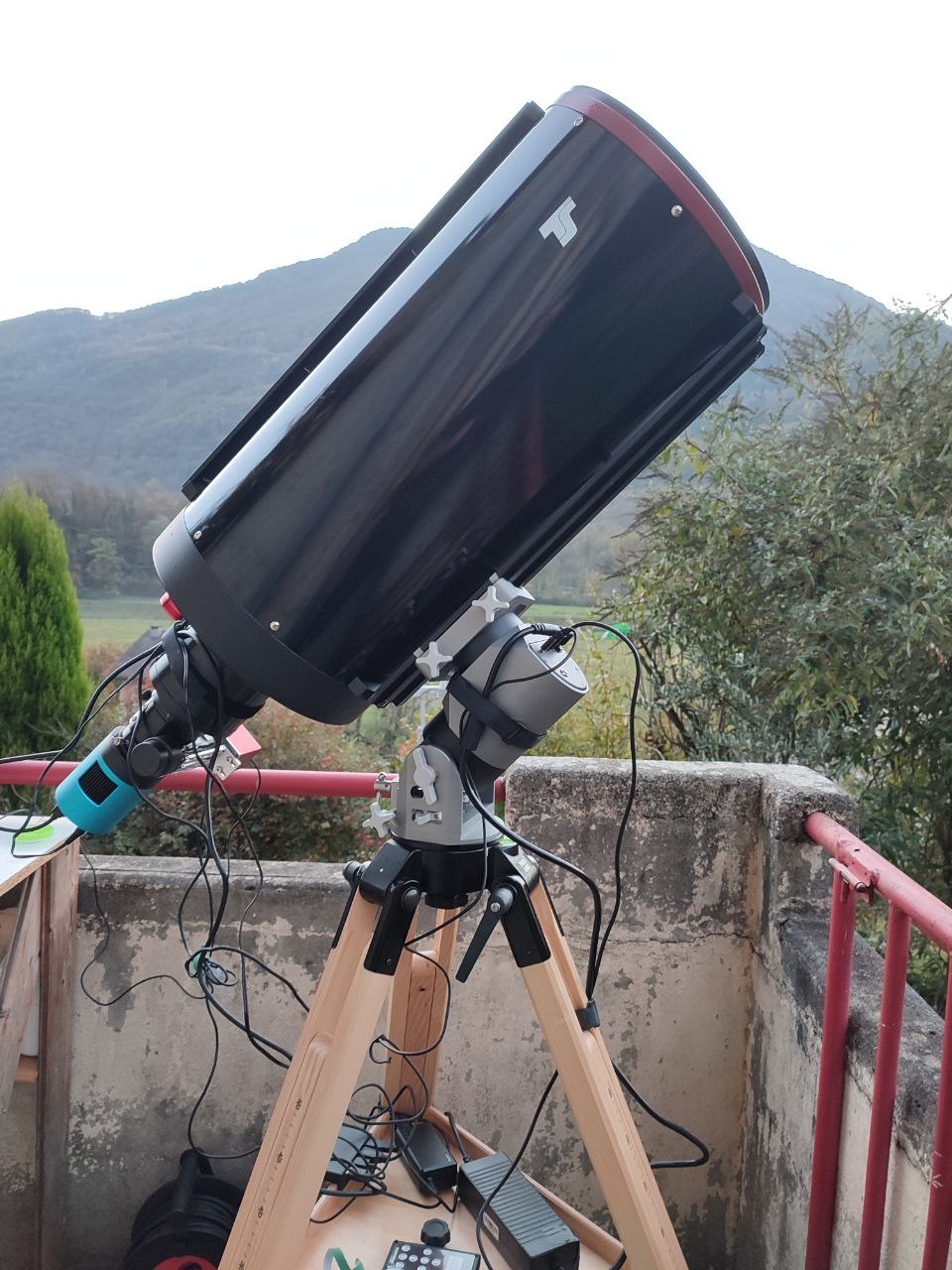 |
You cannot like this item. Reason: "ANONYMOUS".
You cannot remove your like from this item.
Editing a post is only allowed within 24 hours after creating it.
You cannot Like this post because the topic is closed.
Copy the URL below to share a direct link to this post.
This post cannot be edited using the classic forums editor.
To edit this post, please enable the "New forums experience" in your settings.
Olivier Constans:
Below my RC10 , 18kg total weigth with guiding and camera. That's a nice looking setup, but I'm curious why you chose the 10" closed tube RC instead of the 10" Truss. The closed tube has the focuser coupled/attached to the primary mirror cell and I've heard that it's pretty difficult to collimate since you can't see the laser spot on the secondary mirror with out using some other kind of mirror. Also how are you finding the stock focuser? Any tilt, slippage, or other kinds of problems? Lastly, are you using a focal reducer or flattener? If that's an IMX571 camera then you're sampling at a pretty small pixel size ... smaller than the guiding error of 0.4 - 0.7 rms reported above? Thanks for any answers you can provide. I'm seriously considering the 10" truss version myself and would love to hear feedback from actual owners/users.
|
You cannot like this item. Reason: "ANONYMOUS".
You cannot remove your like from this item.
Editing a post is only allowed within 24 hours after creating it.
You cannot Like this post because the topic is closed.
Copy the URL below to share a direct link to this post.
This post cannot be edited using the classic forums editor.
To edit this post, please enable the "New forums experience" in your settings.
Oskari Nikkinen:
Tobiasz:
I have the WD20. I am using it with a RC10 or 8" Newton. My RC imaging setup is around 19-20kg + 5kg counterweight. No backyard setup, just mobile with the Tri Pier.
Works good, no PA bumps after locking in. The mount is backlash free but comes with a PE amplitude of around +-30" and a period of 360s, so aggressive and fast guiding is essential. Guide RMS can be everything between 0.25" and 0.8", depending on your conditions. My Setups are OAG-only.
Drivers are onstep and just work.
CS
* Interested in this mount for similar use in mobile fashion, but with a 10" newtonian.
Have you had a chance to use it in windy conditions yet? If you have, would like to know how it handles gusts and how quickly it can recover from them. My AZ-EQ6 really just doesnt work when its windy so looking for options. *Since the WD20 is so light it does not have the sheer mass to withstand wind gusts in a proper way. Slight wind is fine, but if you have some semi-serious wind gusts you will have a problem. But at this point my old CGX was not any better. I use my car to shield my setup at least partially from wind. I use a guide framerate of up to 15fps and corrections are done every 0.5s my mount recovers from wind gusts very fast.
|
You cannot like this item. Reason: "ANONYMOUS".
You cannot remove your like from this item.
Editing a post is only allowed within 24 hours after creating it.
You cannot Like this post because the topic is closed.
Copy the URL below to share a direct link to this post.
This post cannot be edited using the classic forums editor.
To edit this post, please enable the "New forums experience" in your settings.
John Stone:
Olivier Constans:
Below my RC10 , 18kg total weigth with guiding and camera.
That's a nice looking setup, but I'm curious why you chose the 10" closed tube RC instead of the 10" Truss.
The closed tube has the focuser coupled/attached to the primary mirror cell and I've heard that it's pretty difficult to collimate since you can't see the laser spot on the secondary mirror with out using some other kind of mirror.
Also how are you finding the stock focuser? Any tilt, slippage, or other kinds of problems?
Lastly, are you using a focal reducer or flattener? If that's an IMX571 camera then you're sampling at a pretty small pixel size ... smaller than the guiding error of 0.4 - 0.7 rms reported above?
Thanks for any answers you can provide. I'm seriously considering the 10" truss version myself and would love to hear feedback from actual owners/users. *Sorry if I slide in, RC10 steel tube user here. The stock focuser on my RC was trash to be honest and I quickly exchanged it with a Pegasusastro Prodigy microfocuser. The stock focuser had sag and slippage and I couldn't sacrifice any more clear nights with it. M117 Tilt unit is a must to collimate the focuser, that's a bummer of the steel tube version yes. For collimation I bought an OCAL first, but never got it right because at least one part (primary, secondary or focuser) was off all the time. I thought maybe the center mark on my secondary was not in the right position. Gave up on the OCAL and bought a cheap cheshire and the Lacerta screwable collimation laser. Now with the laser it is a fast and easy process (if the laser itself is properly collimated, too) and 90% of the collimation can be done at home on the table. I dont need any mirrors to align the focuser with the secondary. At least for my RC I can see the center marking reflection on my pinhole target of the collimation laser which is very convenient. The fine tuning of the primary is done via star test (which has to be done by every reflector user imo). Advantage of the closed tube version is that the tube works as a dew shield for the primary in humid regions. I experienced it myself. The secondary may be problematic for both versions, so a secondary mirror heater can be helpful here. Just my 2 cents CS
|
You cannot like this item. Reason: "ANONYMOUS".
You cannot remove your like from this item.
Editing a post is only allowed within 24 hours after creating it.
You cannot Like this post because the topic is closed.
Copy the URL below to share a direct link to this post.
This post cannot be edited using the classic forums editor.
To edit this post, please enable the "New forums experience" in your settings.
John Stone:
Olivier Constans
Below my RC10 , 18kg total weigth with guiding and camera. *** I see no advantage to a truss tube, it is heavier, you have to put a cloth to close the tube and avoid reflection , it is more expensive. The RC10 is easier to collimate than let's say a RC8 or RC6 because you see better the circles of mirors and spider alignement . I have added a tilt ring for 100€ so it makes the focuser no attached to the primary cell. You do the collimation of primary, secondary and at the end the tilt of focuser + adjustement to mirors if necessary. I am using the ocal to collimate , that work very well once you understand what you see. regading the dew , I have a dew tube I made myself, so I have no dew on the secondary miror but the tube is totally wet. The stock focuser is a cheap toy, you have to change it for astrophotography. I use a focal reducer with 0.67 factor (focal 1375mm) . I am using an IMX571 , whit the seeing I have here, my resolution is between 3" and 5" of arc, so the guiding error is far less inferior to that. Below the picture I have just done tonigth (no processing, just out of sharpcap "as seen") with the RC10 , imx571 , 34 min . 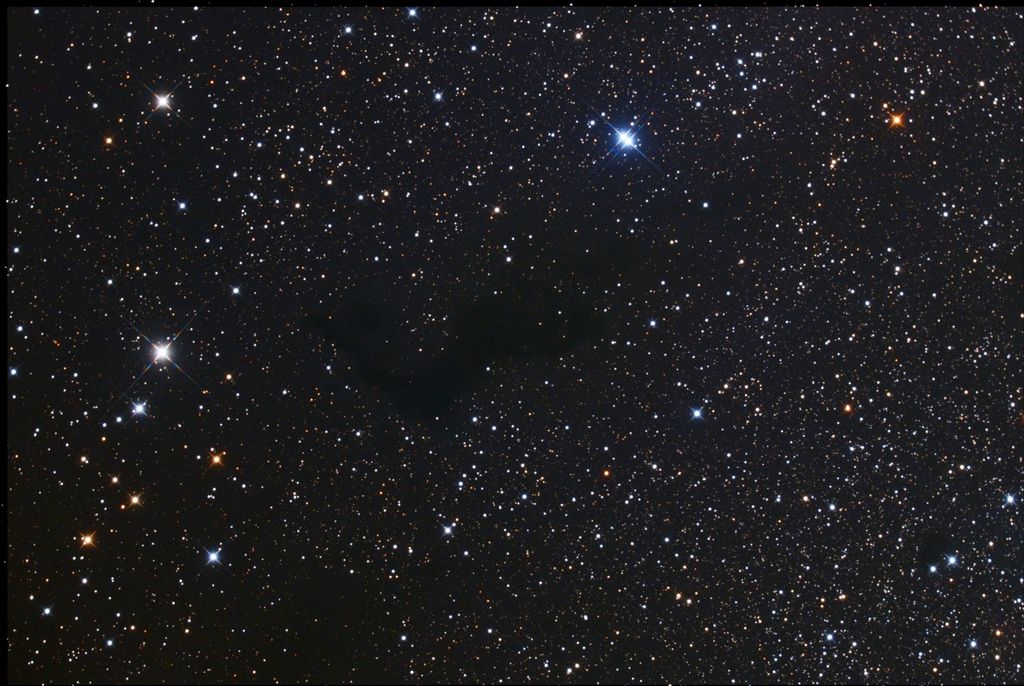 *** |
You cannot like this item. Reason: "ANONYMOUS".
You cannot remove your like from this item.
Editing a post is only allowed within 24 hours after creating it.
You cannot Like this post because the topic is closed.
Copy the URL below to share a direct link to this post.
This post cannot be edited using the classic forums editor.
To edit this post, please enable the "New forums experience" in your settings.
Tobiasz:
Advantage of the closed tube version is that the tube works as a dew shield for the primary in humid regions. I experienced it myself. The secondary may be problematic for both versions, so a secondary mirror heater can be helpful here. *** I agree with that. I have made a dew shield with a yoga mat very efficient, I have no dew on the secondary even when I stay all the nigth with 95% of humidity in the air. ***
|
You cannot like this item. Reason: "ANONYMOUS".
You cannot remove your like from this item.
Editing a post is only allowed within 24 hours after creating it.
You cannot Like this post because the topic is closed.
Copy the URL below to share a direct link to this post.
This post cannot be edited using the classic forums editor.
To edit this post, please enable the "New forums experience" in your settings.
See below an example of the guiding with WD-20 . I can certainly go further in the precision but I this is suffisiant for my seing at home. 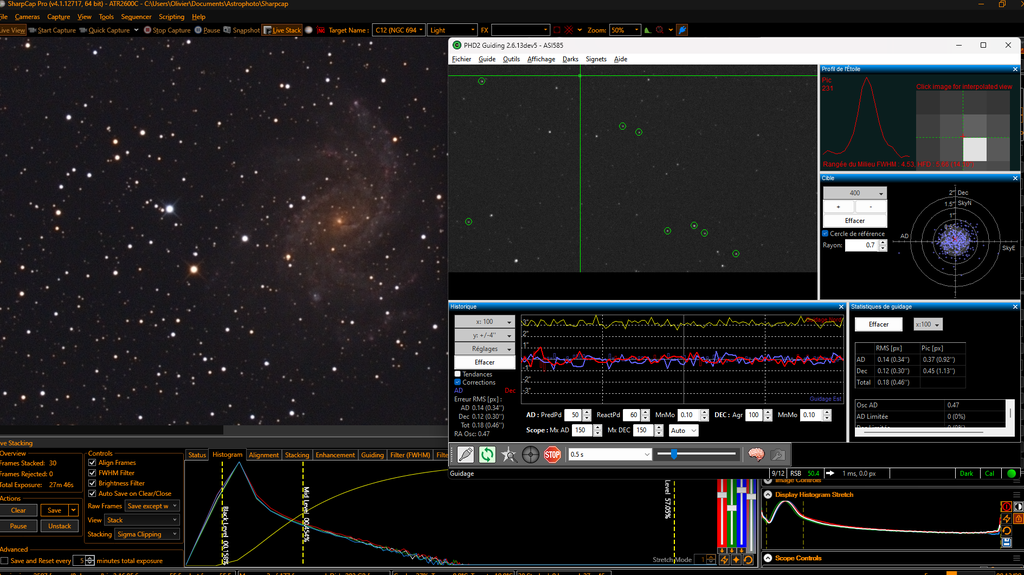 |
You cannot like this item. Reason: "ANONYMOUS".
You cannot remove your like from this item.
Editing a post is only allowed within 24 hours after creating it.
You cannot Like this post because the topic is closed.
Copy the URL below to share a direct link to this post.
This post cannot be edited using the classic forums editor.
To edit this post, please enable the "New forums experience" in your settings.
I also use wd20 with my Newton it's ok but with the C8 I just can't get it to work. I don't get decent results with exposures longer than 180s. Do you have any suggestions? 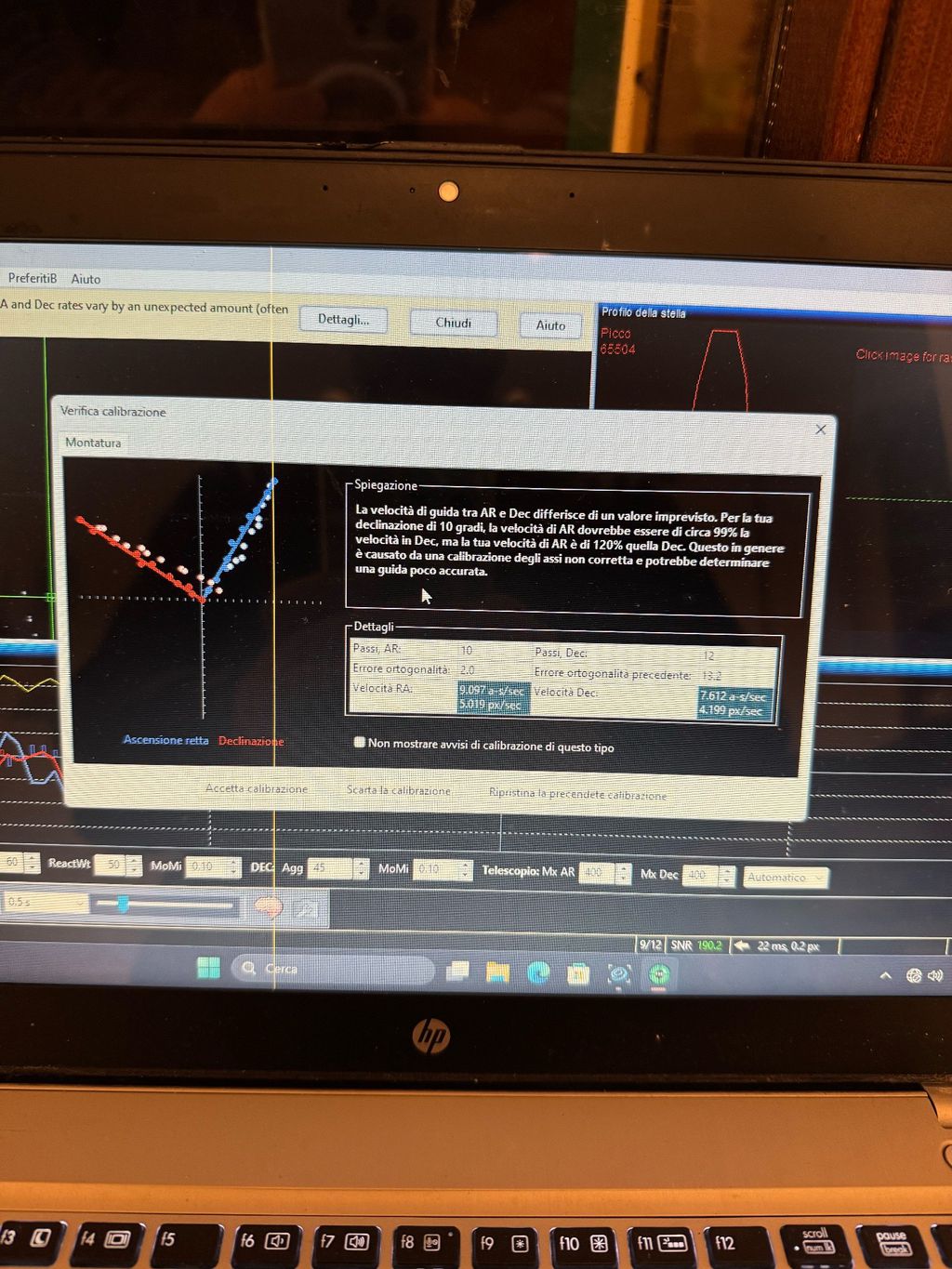 |
You cannot like this item. Reason: "ANONYMOUS".
You cannot remove your like from this item.
Editing a post is only allowed within 24 hours after creating it.
You cannot Like this post because the topic is closed.
Copy the URL below to share a direct link to this post.
This post cannot be edited using the classic forums editor.
To edit this post, please enable the "New forums experience" in your settings.
Olivier Constans:
See below an example of the guiding with WD-20 . I can certainly go further in the precision but I this is suffisiant for my seing at home.
 What are you PHD2 settings? I have an ASI220MM on a PrimaLuce 60mm guide scope on top of an FSQ-106 EDX4 + PL Eagle 5 Pro. I rarely get anything under 0.7" so I'm pretty sure something is up with my settings. It's totally stable (mounted on a Berlebach Planet Small tripod). For comparison, I also have a Tak e-130d on an AM5 with an ASI2600MC Duo and get much better guiding using pretty much default PHD2 settings (steps adjusted for focal length).
|
You cannot like this item. Reason: "ANONYMOUS".
You cannot remove your like from this item.
Editing a post is only allowed within 24 hours after creating it.
You cannot Like this post because the topic is closed.
Copy the URL below to share a direct link to this post.
This post cannot be edited using the classic forums editor.
To edit this post, please enable the "New forums experience" in your settings.
Has anyone got it to work properly with an ASIAIR? I flipped the settings for the meridian flip but it’s still not working after a flip. Prior to the flip I get very good guiding.
|
You cannot like this item. Reason: "ANONYMOUS".
You cannot remove your like from this item.
Editing a post is only allowed within 24 hours after creating it.
You cannot Like this post because the topic is closed.
Copy the URL below to share a direct link to this post.
This post cannot be edited using the classic forums editor.
To edit this post, please enable the "New forums experience" in your settings.
this phd2 sett for newton 800/200 and 250/50 I’m pretty much for this equipment. Different when used my c8 whit 60/330 guide scope the Ra is very high around 0.8/1”. I listen many people have best results whit zwo Am5 i believe the wd20 is best compared and zwo 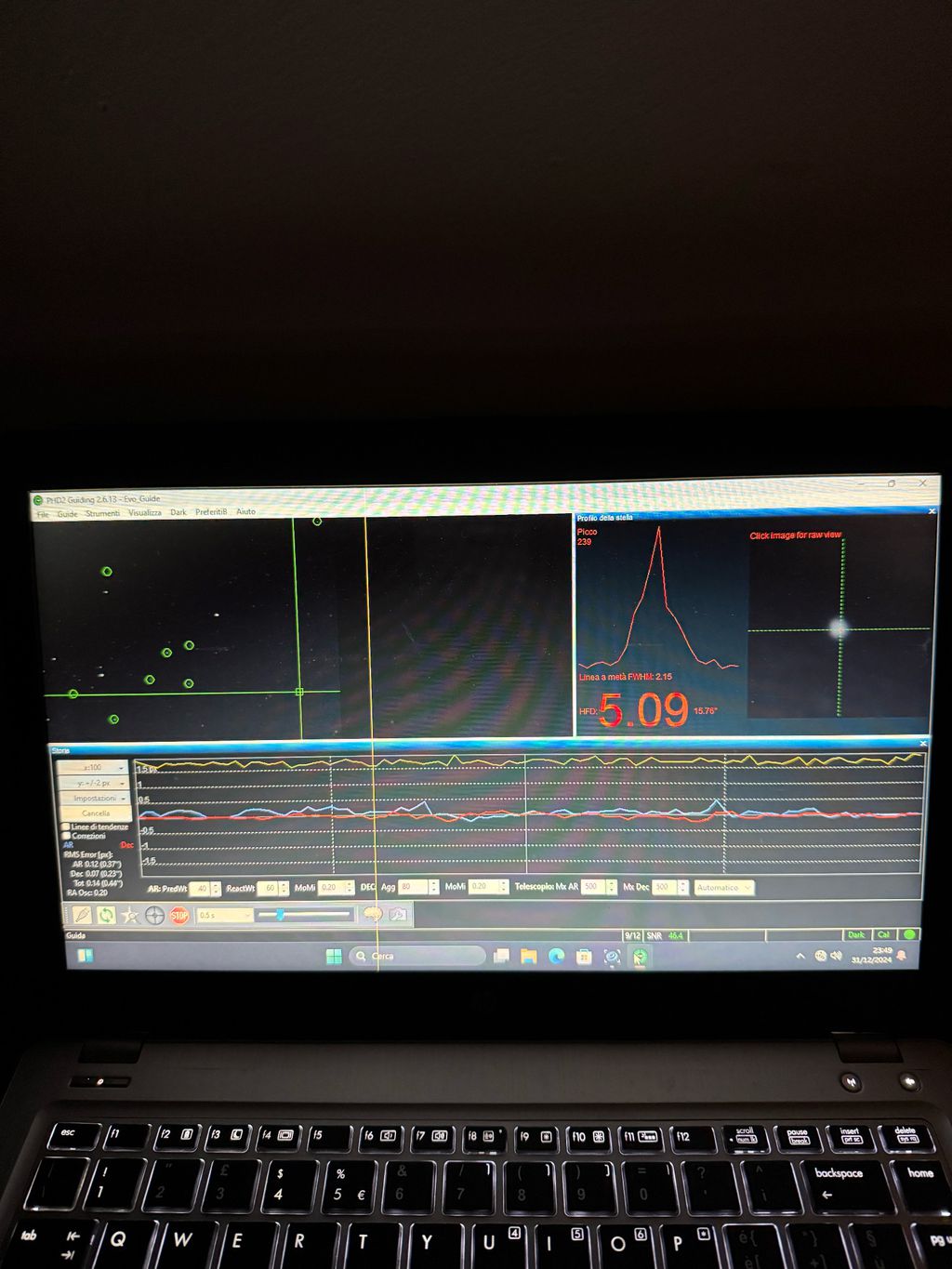 |
You cannot like this item. Reason: "ANONYMOUS".
You cannot remove your like from this item.
Editing a post is only allowed within 24 hours after creating it.
You cannot Like this post because the topic is closed.
Copy the URL below to share a direct link to this post.
This post cannot be edited using the classic forums editor.
To edit this post, please enable the "New forums experience" in your settings.
Gustavo Tandeciarz:
Olivier Constans:
See below an example of the guiding with WD-20 . I can certainly go further in the precision but I this is suffisiant for my seing at home.

What are you PHD2 settings?
I have an ASI220MM on a PrimaLuce 60mm guide scope on top of an FSQ-106 EDX4 + PL Eagle 5 Pro. I rarely get anything under 0.7" so I'm pretty sure something is up with my settings.
It's totally stable (mounted on a Berlebach Planet Small tripod).
For comparison, I also have a Tak e-130d on an AM5 with an ASI2600MC Duo and get much better guiding using pretty much default PHD2 settings (steps adjusted for focal length). Hello, these are my last settings . 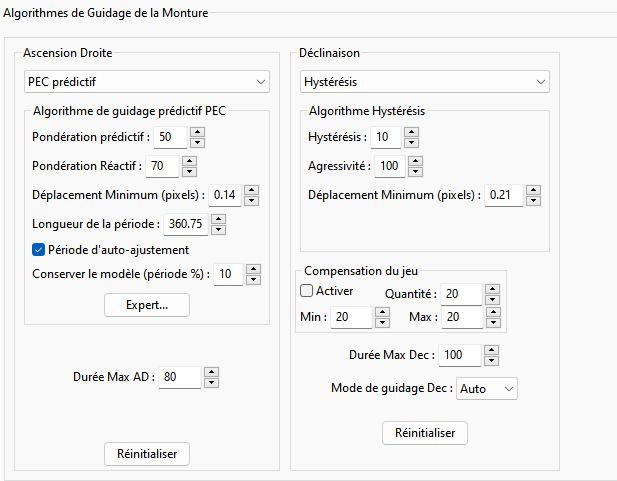 I generally have a total rms between 0.46 et 0.6 depending the condition and the direction I am pointing the sky. I am using most of the time a very short time of exposure (when the seing is good) of 0.2s . When it is not going I use 0.5s. I am still experimenting to get something better, but until now I was never abble to go under 0.14 pixel. I also figured out that it is better to try to balance correctly the scope in the mount , especially in Dec because you have no brake and unbalanced scope may give issue (I have a 20kg payload on that mount).
|
You cannot like this item. Reason: "ANONYMOUS".
You cannot remove your like from this item.
Editing a post is only allowed within 24 hours after creating it.
You cannot Like this post because the topic is closed.
Copy the URL below to share a direct link to this post.
This post cannot be edited using the classic forums editor.
To edit this post, please enable the "New forums experience" in your settings.
Thanks for share, next time try with your parameters. My setup is down 20kg but i believe with 1600mm of focal is more hard.I have used a string under the handle to find the center of the balance. What do you do for find the center of dec you know the best method..?
|
You cannot like this item. Reason: "ANONYMOUS".
You cannot remove your like from this item.
Editing a post is only allowed within 24 hours after creating it.
You cannot Like this post because the topic is closed.
Copy the URL below to share a direct link to this post.
This post cannot be edited using the classic forums editor.
To edit this post, please enable the "New forums experience" in your settings.
Personally, I stopped using PHD2 and switched over to Metaguide. It seems the guiding algorithm from PHD2 is not really optimised for HD mounts with very large PE like the WD20 has, it shows you good guiding numbers but the eccentricity of the stars was not good and they were oblong. The centroid of the star moves away too fast in the highest PE slope and will be calculated wrong. That was my experience @2000mm FL and 0,76 pix/arcsec image scale. There is a very informative paper on this particular topic from Kok Chen: http://www.w7ay.net/site/Downloads/AutoGuiding/Rough/index.htmlYou can try in PHD2: Expose as many frames as possible per second (at least 1fps, better is 2-5 fps or more) Guide as many stars as possible for multistar guiding Guider image scale similiar to your imaging scale or better (OAG or guide scope with barlow) for best centroid calculation Guide pulse duration not longer than your guide camera exposure time (e.g. 2fps -> RA/DEC duration max. 500ms) Enable predictive PEC for RA with a higher predictive setting (depends on your payload) Use the smallest MinMo value possible You can try with your WD20: Reduce tracking speed to lowest setting -> 0.25x sidereal (slower movement = slower errors = higher chance to correct the error early enough) In the WD20 discord users complained about double stars in their long exposures despite extremely good guiding graphs while doing long focal length imaging. The high PE of the WD20 is the reason. Since I use metaguide, my guiding graph looks the same as in PHD but my stars are tighter, round and the eccentricity is no problem anymore, weird isn't it? And the number of tossed subs is reduced to almost zero per night. I guide with 2 corrections per second and exposure time is between 5 and 15 fps (Metaguide records video via Dshow driver and stacks the frames for centroid calculation). CS
|
You cannot like this item. Reason: "ANONYMOUS".
You cannot remove your like from this item.
Editing a post is only allowed within 24 hours after creating it.
You cannot Like this post because the topic is closed.
Copy the URL below to share a direct link to this post.
This post cannot be edited using the classic forums editor.
To edit this post, please enable the "New forums experience" in your settings.
Tobiasz:
Personally, I stopped using PHD2 and switched over to Metaguide. It seems the guiding algorithm from PHD2 is not really optimised for HD mounts with very large PE like the WD20 has, it shows you good guiding numbers but the eccentricity of the stars was not good and they were oblong. The centroid of the star moves away too fast in the highest PE slope and will be calculated wrong. That was my experience @2000mm FL and 0,76 pix/arcsec image scale.
There is a very informative paper on this particular topic from Kok Chen: http://www.w7ay.net/site/Downloads/AutoGuiding/Rough/index.html
You can try in PHD2:
Expose as many frames as possible per second (at least 1fps, better is 2-5 fps or more)
Guide as many stars as possible for multistar guiding
Guider image scale similiar to your imaging scale or better (OAG or guide scope with barlow) for best centroid calculation
Guide pulse duration not longer than your guide camera exposure time (e.g. 2fps -> RA/DEC duration max. 500ms)
Enable predictive PEC for RA with a higher predictive setting (depends on your payload)
Use the smallest MinMo value possible
You can try with your WD20:
Reduce tracking speed to lowest setting -> 0.25x sidereal (slower movement = slower errors = higher chance to correct the error early enough)
In the WD20 discord users complained about double stars in their long exposures despite extremely good guiding graphs while doing long focal length imaging. The high PE of the WD20 is the reason.
Since I use metaguide, my guiding graph looks the same as in PHD but my stars are tighter, round and the eccentricity is no problem anymore, weird isn't it? And the number of tossed subs is reduced to almost zero per night. I guide with 2 corrections per second and exposure time is between 5 and 15 fps (Metaguide records video via Dshow driver and stacks the frames for centroid calculation). |
You cannot like this item. Reason: "ANONYMOUS".
You cannot remove your like from this item.
Editing a post is only allowed within 24 hours after creating it.
You cannot Like this post because the topic is closed.
Copy the URL below to share a direct link to this post.
This post cannot be edited using the classic forums editor.
To edit this post, please enable the "New forums experience" in your settings.
Alessio:
Tobiasz:
Personally, I stopped using PHD2 and switched over to Metaguide. It seems the guiding algorithm from PHD2 is not really optimised for HD mounts with very large PE like the WD20 has, it shows you good guiding numbers but the eccentricity of the stars was not good and they were oblong. The centroid of the star moves away too fast in the highest PE slope and will be calculated wrong. That was my experience @2000mm FL and 0,76 pix/arcsec image scale.
There is a very informative paper on this particular topic from Kok Chen: http://www.w7ay.net/site/Downloads/AutoGuiding/Rough/index.html
You can try in PHD2:
Expose as many frames as possible per second (at least 1fps, better is 2-5 fps or more)
Guide as many stars as possible for multistar guiding
Guider image scale similiar to your imaging scale or better (OAG or guide scope with barlow) for best centroid calculation
Guide pulse duration not longer than your guide camera exposure time (e.g. 2fps -> RA/DEC duration max. 500ms)
Enable predictive PEC for RA with a higher predictive setting (depends on your payload)
Use the smallest MinMo value possible
You can try with your WD20:
Reduce tracking speed to lowest setting -> 0.25x sidereal (slower movement = slower errors = higher chance to correct the error early enough)
In the WD20 discord users complained about double stars in their long exposures despite extremely good guiding graphs while doing long focal length imaging. The high PE of the WD20 is the reason.
Since I use metaguide, my guiding graph looks the same as in PHD but my stars are tighter, round and the eccentricity is no problem anymore, weird isn't it? And the number of tossed subs is reduced to almost zero per night. I guide with 2 corrections per second and exposure time is between 5 and 15 fps (Metaguide records video via Dshow driver and stacks the frames for centroid calculation). thanks Tobiasz, some time ago I tried metaguide without success, it did not see my camera and so I am forced to use phd2. I have buy the wd20 for one future project and any telescope more heavy same C11 . But later i have listen all this problem maybe was good Zwo Am5 . wen the sky has clear i have much to do. thanks for your response
|
You cannot like this item. Reason: "ANONYMOUS".
You cannot remove your like from this item.
Editing a post is only allowed within 24 hours after creating it.
You cannot Like this post because the topic is closed.
Copy the URL below to share a direct link to this post.
This post cannot be edited using the classic forums editor.
To edit this post, please enable the "New forums experience" in your settings.
Alessio:
Thanks for share, next time try with your parameters. My setup is down 20kg but i believe with 1600mm of focal is more hard.I have used a string under the handle to find the center of the balance. What do you do for find the center of dec you know the best method..? I have put all the equipment on my RC10 (camera, filters and filter wheel, guide scope and its camera, dew tube) , then I put the RC10 tube on a tigth piece of wooed and move the tube to find the correct balance and then I marked the position with some adhesive paper on the lossmandy plate. The other possibility, you put the OTA on the WD20 with all equipement and you manually put the OTA horizontal on the declinaison axe (without power on the mount) . It is easy to move the dec axis by hand has there is no brake on that axe. And then you move the OTA until it is balanced and the DEC axes don't move alone by the unbalanced weigth. Then you mark the position.
|
You cannot like this item. Reason: "ANONYMOUS".
You cannot remove your like from this item.
Editing a post is only allowed within 24 hours after creating it.
You cannot Like this post because the topic is closed.
Copy the URL below to share a direct link to this post.
This post cannot be edited using the classic forums editor.
To edit this post, please enable the "New forums experience" in your settings.
DavesView:
Jan Erik Vallestad:
You clearly seem very concerned with low RMS, so pardon me for assuming this was your end goal. It sure comes off as it is, despite the wording "goal(s)".
OK! So my apologies for ramping this discussion up. As you might notice, I edited the post as a second thought on wording, but apparently not before you replied to it. Of course the end goal should probably be the final product, which is the image. The saying, the proof is in the pudding, and the image is the pudding. So I get it and again, my apologies. Maybe a low RMS is not important, or required, but I like it. Besides, if you see my images, you'll know there has got to be something else keeping me in this hobby. lol Dave, I hope you achieve your goal(s). I'm sure it is doable at some price. I use the AM5 for my FLT91 with my goal of getting near perfect guiding at the under sampled conditions of my optics, essentially perfect stars, etc, etc. I actually never fully tighten down my mount. Seems like everyone one who has responded here does. My mount is tightened enough to not really have any play in it yet still allowing enough to be adjusted. If you looked at my last image and I told you my PA was better than 1" arc, you could not prove me wrong. But I admit, I would be lying! Keep us posted when you get the new mount. And to open another can of worms, getting 1" arc doesn't mean a hill of beans if your level is off. (Never mind soft ground, changing temps, whatever.). Frustrating me is my AM5 has two level bubbles. They never agree! Pretty sloppy, but really they are for getting close only. I bought a precise level to get final level, but the AM5 does not have two surfaces where I can place the level at 90 degrees, so it takes me longer to get level than to get PA. In scientific and engineering parlance, it is understood that getting a precision of one variable to the nth decimal position is meaningless if any one other impacting variable cannot be set as precisely. On the other hand your hobby is metrology...
|
You cannot like this item. Reason: "ANONYMOUS".
You cannot remove your like from this item.
Editing a post is only allowed within 24 hours after creating it.
You cannot Like this post because the topic is closed.
Copy the URL below to share a direct link to this post.
This post cannot be edited using the classic forums editor.
To edit this post, please enable the "New forums experience" in your settings.








